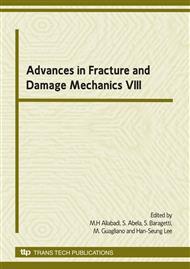[1]
Chen G, Ushida T, Tateishi T. Preparation of poly and poly foams by use of ice microparticulates. Biomaterials , 2001, vol. 22, pp.2563-2567.
DOI: 10.1016/s0142-9612(00)00447-6
Google Scholar
[2]
Gao J , Niklason L , Langer R. Surface hydrolysis of poly ( glycolicacid) meshes increases the seeding density of vascular smooth muscle cells. J Biomed Mater Res , 1998, vol. 42 , pp.417-424.
DOI: 10.1002/(sici)1097-4636(19981205)42:3<417::aid-jbm11>3.0.co;2-d
Google Scholar
[3]
A.S. Rowlands S.A. Lim,D. Martin J.J. Cooper-White. Polyurethane/poly (lactic-co-glycolic) acid composite scaffolds fabricated by thermally induced phase separation. Biomaterials, 2007, vol. 28, pp.2109-2121.
DOI: 10.1016/j.biomaterials.2006.12.032
Google Scholar
[4]
Teng Xinrong, Ren Jie, Zhu Lihua. Preparation of porous PLA scaffold materials by supercritical CO2/salt-leaching method. J. Wuhan Inst. Chem. Tech., 2005, vol. 27, pp.42-46.
Google Scholar
[5]
Zhang Run, Deng Zhang xing, Li Lihua. Preparation of porous PLA scaffold materials by supercritical CO2. Chinese Journal of material research, 2003, vol. 17, pp.666-670.
Google Scholar
[6]
Guo Chao, Dong Yinsheng, Lin Pinghua1. Studyon fabrication of poly(lacticacid) porous scaffolds. Journal of Southeast University (Natural Science Editio), 2004, vol. 34, pp.496-499.
Google Scholar
[7]
Shi Guixin, Wang Shenguo, Bei Jianzhong. Preparation of Porous cell Scaffolds of Poly and Poly and the Measurement of the Porositie. Journal of Functional Polyme, 2001, vol. 14, pp.7-10.
Google Scholar
[8]
C. Guopin, Takashi Ushida, Tetsuya Tateishi. Preparation of poly and poly foams by use of ice microparticulates. Biomaterial, 2003, vol. 22, pp.2563-2576.
DOI: 10.1016/s0142-9612(00)00447-6
Google Scholar
[9]
Su Aihua, Wang Yuanliang, Luo Yanfeng, Wu Keda. Compatibility of a Novel Ethylenediamine Modified Polylactic Acid with Osteoblasts. J Biomed Eng. J Biomed Eng, 2005, vol. 22, pp.708-710.
Google Scholar
[10]
Li Xuesheng, Huang Jinzhong. A study on neocartilage formation using chondrocytes-newstyle PLA polymer autograft. Moden Rehabilitation, 2006, vol. 5, pp.43-45.
Google Scholar
[11]
Chen Xuxuan, Nu Chuntang. Biocompatibility and biodegradation of absorbable material of poly in vivo. J Fourth Mil Med Univ, 2003, 21(4) J Fourth Mil Med Univ, 2003, vol. 21, pp.60-64.
Google Scholar
[12]
Zhang Li, Lu Chuntang, Zhou Shuxi. Biocompatibility of bioabsorbable fracture-fixation materialsofpoly (LDL-lactide) in vivo. J Pract Stomatol, vol. 16, 2000, pp.363-367.
Google Scholar


